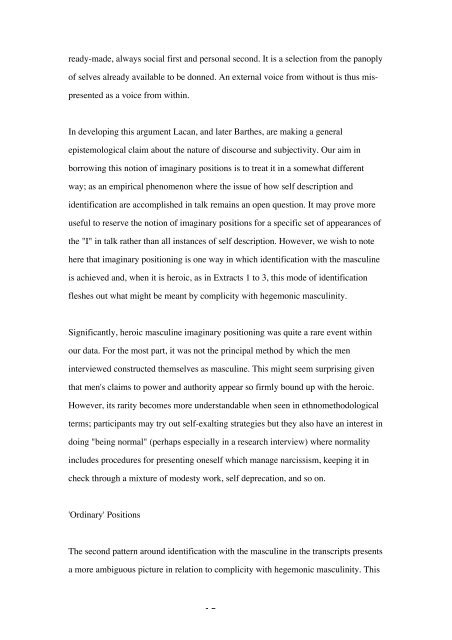Negotiating Hegemonic Masculinity: Imaginary ... - UCSB Linguistics
Negotiating Hegemonic Masculinity: Imaginary ... - UCSB Linguistics
Negotiating Hegemonic Masculinity: Imaginary ... - UCSB Linguistics
You also want an ePaper? Increase the reach of your titles
YUMPU automatically turns print PDFs into web optimized ePapers that Google loves.
eady-made, always social first and personal second. It is a selection from the panoply<br />
of selves already available to be donned. An external voice from without is thus mis-<br />
presented as a voice from within.<br />
In developing this argument Lacan, and later Barthes, are making a general<br />
epistemological claim about the nature of discourse and subjectivity. Our aim in<br />
borrowing this notion of imaginary positions is to treat it in a somewhat different<br />
way; as an empirical phenomenon where the issue of how self description and<br />
identification are accomplished in talk remains an open question. It may prove more<br />
useful to reserve the notion of imaginary positions for a specific set of appearances of<br />
the "I" in talk rather than all instances of self description. However, we wish to note<br />
here that imaginary positioning is one way in which identification with the masculine<br />
is achieved and, when it is heroic, as in Extracts 1 to 3, this mode of identification<br />
fleshes out what might be meant by complicity with hegemonic masculinity.<br />
Significantly, heroic masculine imaginary positioning was quite a rare event within<br />
our data. For the most part, it was not the principal method by which the men<br />
interviewed constructed themselves as masculine. This might seem surprising given<br />
that men's claims to power and authority appear so firmly bound up with the heroic.<br />
However, its rarity becomes more understandable when seen in ethnomethodological<br />
terms; participants may try out self-exalting strategies but they also have an interest in<br />
doing "being normal" (perhaps especially in a research interview) where normality<br />
includes procedures for presenting oneself which manage narcissism, keeping it in<br />
check through a mixture of modesty work, self deprecation, and so on.<br />
'Ordinary' Positions<br />
The second pattern around identification with the masculine in the transcripts presents<br />
a more ambiguous picture in relation to complicity with hegemonic masculinity. This<br />
15
















